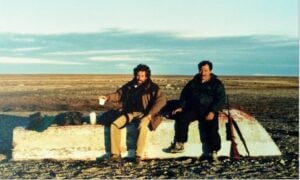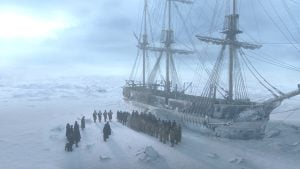In the winter of 1846, John Hartnell, an able seaman aboard the HMS Terror, died of tuberculosis, becoming one of the first casualties of Sir John Franklin’s doomed Arctic expedition. One hundred and forty years later, his remains, immaculately preserved in the permafrost of Beechey Island, provided anthropologists with the first concrete evidence that Franklin’s men may have suffered from lead poisoning.
Now, new technologies are allowing scientists to take another look at Hartnell’s tissues in hopes of learning more about what befell the lost expedition.
A new Canadian study, published December 6 in the Journal of Archaeological Science: Reports, suggests that malnutrition played a major role in Hartnell’s death and may account for the high levels of lead found in his tissues.
The study, led by toxicologist Jennie Christensen of TrichAnalytics and supported by Stantec Consulting, tested for quantities of lead, copper, zinc, arsenic and other metals in Hartnell’s toenail and thumbnail — retrieved during the exhumation of his grave in the 1980s — and compared them with the nails of a healthy adult male.
As they grow, nails retain the elements that are present in the body at a given time, creating a continuous record of a person’s health over a period of months — in Hartnell’s case, dating back to the first weeks of the expedition.
Hartnell’s nails, particularly the toenail, were heavily contaminated with coal dust and other ambient dirt that could skew the results, so Christensen and fellow researchers Joyce McBeth and Nicole Sylvain of the University of Saskatchewan used synchrotron micro-x-ray techniques to map the metal content of the underside of the thumbnail, where it would have been in contact with Hartnell’s skin.
Christensen says she expected the analysis to support the theory, advanced by previous lead isotope studies of crew members’ bones and organs, that Hartnell was being slowly poisoned by the lead in the expedition’s food tins, or Terror’s water supply, from the moment the ship left England, but what she found instead was surprising.
“We were expecting to see elevations in the lead content [of the nail] over time, but it was a flatline, right through the early voyage on the sea and the Beechey Island timeframe,” she says. It was only in the last weeks of his life, when he was in the final throes of tuberculosis, that the concentration of lead in Hartnell’s blood spiked, from a healthy level of less than five parts per million (ppm) to 50 ppm.
Christensen attributes this spike not to environmental exposure, but the fact that Hartnell was gravely ill, and his starving body had begun to consume its own bone, fat and muscle, releasing stored toxins into his bloodstream.
“He contaminated himself, essentially,” Christensen says.
The zinc results offer a clue as to why Hartnell sickened and died so quickly: he was malnourished.
“We focused on zinc and copper because they are highly linked with diet — you can get a lot from meat and seafood,” Christensen explains. “We were interested to see what he was eating, because they had proposed to hunt for marine animals.”
A spike in the zinc content of Hartnell’s nail around mid-July 1845 corresponds with historical accounts that place the ships in Greenland, where they slaughtered oxen. But as winter set in and the expedition became trapped in ice at Beechey Island, Hartnell’s nail shows he became severely, chronically zinc-deficient, suggesting he was not eating enough meat.
Zinc is critical to helping the body absorb Vitamin A, which supports a healthy immune system; without it, Hartnell would not have been able to fight off the TB bacteria lurking in his body.
The study concludes that lead was “a major piece of a very complex puzzle” of factors affecting Franklin’s men, but that the results from Hartnell’s nail indicate malnutrition deserves a closer look.
“A lack of zinc didn’t cause the demise of the expedition, but it is an indication that they were malnourished and their health wasn’t great,” Christensen says. “When you add on other factors like severe environmental conditions, stress, and the TB bacterium, you’re asking for trouble.”





